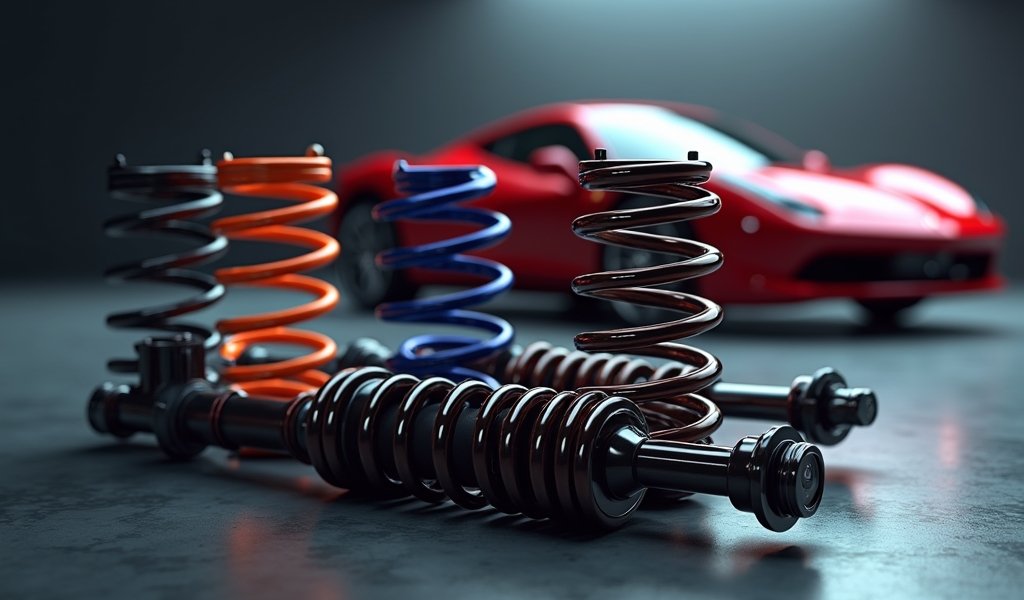Overview
This article provides a detailed guide on selecting the right coilover spring rates for your vehicle, explaining how spring rates affect handling and ride comfort while offering calculation methods and recommendations for different driving styles. The author emphasizes that proper spring rate selection depends on vehicle weight, intended use, and personal preferences, with the recommendation to start with more conservative rates and make incremental adjustments based on real-world testing.
Table of Contents
- Introduction
- Understanding Spring Rates
- Factors That Influence Spring Rate Selection
- Calculating Base Spring Rates
- Fine-Tuning Your Selection
- Common Spring Rate Recommendations
- Testing and Adjustment
- Conclusion
- Frequently Asked Questions
Introduction
Ever felt like your car is bouncing around like a pogo stick on rough roads, or maybe it corners like a boat in a storm? The culprit might be your suspension setup, specifically your coilover spring rates. As a mechanic who’s seen countless vehicles transformed by proper suspension tuning, I can tell you that getting your coilover spring rate selection right is like finding that perfect spice balance in your favorite recipe – it changes everything.
Coilover suspension systems combine a shock absorber with a coil spring, giving you the ability to adjust ride height and, depending on the system, damping characteristics. But here’s the thing – even the most expensive coilovers won’t perform well if you’ve got the wrong spring rates for your vehicle and driving style. It’s like putting premium fuel in a car with engine problems – you’re not fixing the underlying issue.
Don’t worry though! What seems complicated at first glance can be broken down into straightforward principles. In this guide, I’ll walk you through the process of selecting the ideal coilover spring rates without drowning you in technical jargon. Whether you’re building a weekend track warrior or just want a better-handling daily driver, getting your coilover spring rate selection right will transform your driving experience.
Understanding Spring Rates
Let’s start with the basics – what exactly is a spring rate? Simply put, it’s a measurement of how much force is required to compress a spring by a specific distance. In the automotive world, spring rates are typically measured in kilograms per millimeter (kg/mm) or pounds per inch (lbs/in). A 10 kg/mm spring, for example, requires 10 kilograms of force to compress it one millimeter.
Think of spring rates like mattress firmness. Too soft, and you’ll sink in uncomfortably (or in car terms, experience excessive body roll and poor handling). Too firm, and you’ll feel every little bump and pebble (translating to a harsh, uncomfortable ride). The sweet spot depends entirely on what you’re looking for in your driving experience.
Higher spring rates create a stiffer suspension setup, which generally improves handling by reducing body roll, providing better response during direction changes, and maintaining more consistent tire contact during aggressive driving. However, this comes at the expense of ride comfort, as stiffer springs transmit more road imperfections into the cabin.
Lower spring rates, on the other hand, prioritize comfort by absorbing bumps and road irregularities more effectively. The trade-off is increased body roll during cornering and potentially less precise handling. This doesn’t mean softer springs are “worse” – for many daily drivers that rarely see track time, a more compliant setup might be exactly what’s needed.
Your vehicle’s weight plays a crucial role in determining appropriate spring rates. Heavier vehicles require stiffer springs to support their mass properly. It’s a bit like how a heavier person needs a firmer mattress for proper support. Understanding this relationship between vehicle weight and spring rate is your first step toward upgrading your car’s suspension performance.

Factors That Influence Spring Rate Selection
Choosing the right spring rate isn’t just about looking up what other people use. Your perfect setup depends on several key factors that are unique to your situation. Let’s break them down:
Vehicle weight and distribution are perhaps the most fundamental considerations. A lightweight Miata will need significantly lower spring rates than a hefty Charger. More importantly, the weight distribution between the front and rear axles determines the relative spring rates needed. Front-heavy cars typically need stiffer front springs to compensate.
Your intended use makes an enormous difference. Are you building a dedicated track car that will see regular rallycross competition? You’ll likely want stiffer springs than someone who occasionally attends track days but primarily drives on public roads. For pure street cars, comfort becomes a much higher priority.
Driving style preferences matter more than many people realize. Some drivers prefer a car that feels planted and communicative, with minimal body roll – even at the expense of ride comfort. Others prioritize a plush ride and don’t mind some body movement during spirited driving. Neither approach is inherently right or wrong – it’s about what feels best to you.
Suspension geometry and motion ratios get a bit more technical. Different suspension designs (MacPherson strut, double wishbone, multi-link, etc.) have different leverage ratios. This means that the effective spring rate at the wheel can differ significantly from the actual spring rate. A knowledgeable suspension shop or engineer can help you understand your specific setup’s requirements.
Additional modifications should also influence your decision. If you’ve added chassis bracing, a roll cage, or significant aero elements, these all affect how your car handles and may require spring rate adjustments. Similarly, substantial weight reduction measures might mean you can run softer springs than stock while maintaining handling performance.
Finally, consider your local driving environment. Smooth highways and race tracks allow for stiffer setups, while pothole-riddled city streets might make you appreciate a more compliant setup, regardless of the small handling penalty. According to Car and Driver’s suspension guide, finding the right balance for your specific driving conditions is crucial for long-term satisfaction with your setup.
Calculating Base Spring Rates
Now for the part you’ve been waiting for – how do we actually calculate appropriate spring rates? While professional race teams use complex suspension modeling software, I’ll give you some practical methods that have served me well over decades in the garage.
The simplest starting point is the “one percent rule” – a spring rate that allows approximately one percent of compression under the corner weight of the vehicle. For example, if your front left corner weighs 800 pounds, a good starting spring rate might be around 800 pounds per inch (approximately 14 kg/mm). This is just a baseline, though, and will need adjustment based on your specific needs.
For a more refined approach, we need to consider weight transfer during cornering. As a rule of thumb, front spring rates typically range from 1.5% to 2.5% of the front corner weight for street cars, while track-focused setups might use 2.5% to 4%. Rear springs are generally 10-30% stiffer than what the same calculation would yield, especially in front-wheel-drive vehicles, to help control weight transfer.
Let’s walk through a quick example:
- Vehicle weight: 3200 lbs
- Weight distribution: 60% front, 40% rear
- Front corner weight: 3200 × 0.6 ÷ 2 = 960 lbs per front corner
- Rear corner weight: 3200 × 0.4 ÷ 2 = 640 lbs per rear corner
- Street-oriented front spring rate: 960 × 0.02 = 19.2 kg/mm (approximately)
- Street-oriented rear spring rate: (640 × 0.02) × 1.2 = 15.4 kg/mm (with 20% increase)
Remember these calculations provide starting points, not absolute answers. If you’re serious about optimizing your suspension, consider getting your car corner-weighted on professional scales. This process provides exact weight measurements for each corner of the vehicle, allowing for much more precise spring rate calculations.
For those looking to dive deeper, the technical articles from Longacre Racing provide excellent insights into more advanced spring rate calculations that account for factors like suspension travel and motion ratios.
Finally, don’t forget the importance of maintaining proper front-to-rear balance. Generally, you want a slightly higher natural frequency at the rear compared to the front, which typically means proportionally stiffer rear springs. This helps prevent unpleasant handling characteristics like snap oversteer. Most street cars run rear spring rates that are 10-20% higher relative to weight than the fronts, but this varies significantly based on drivetrain layout.
Fine-Tuning Your Selection
Once you’ve calculated your baseline spring rates, it’s time to fine-tune based on your specific vehicle and goals. Think of this stage as custom-tailoring a suit – the initial measurements get you close, but the final adjustments make it truly fit your unique needs.
One of the first decisions you’ll face is choosing between linear and progressive springs. Linear springs maintain the same rate throughout their compression range, providing predictable handling that many enthusiasts prefer for track use. Progressive springs, on the other hand, start softer and become stiffer as they compress, offering a balance of comfort and performance that works well for street cars. If you’re building a dual-purpose vehicle, progressive springs might be the sweet spot.
Consider making adjustments if your car has undergone significant modifications. Weight reduction measures like removing the back seat or swapping to lighter components might allow you to run slightly softer springs while maintaining good handling. Conversely, adding a roll cage or substantial aero elements typically requires stiffer springs to manage the added weight or downforce.
Regional driving conditions should also factor into your fine-tuning. If you live in an area with smooth roads or primarily drive on race tracks, you can lean toward the stiffer end of the spectrum. Drivers contending with rough streets, seasonal frost heaves, or numerous speed bumps might want to dial back stiffness by 10-15% from the calculated values to preserve their vertebrae (and their car’s undercarriage).
Don’t forget to consider lowering spring compatibility with other components. Significant lowering can affect suspension geometry and potentially require additional modifications like adjustable control arms to restore proper alignment. A general rule of thumb is that for every inch of lowering, you may need to increase spring rates by 10-15% to maintain proper suspension function and prevent bottoming out.
Finally, if you’re stuck between two spring rates, I usually advise my customers to start with the softer option. It’s easier to move up to a stiffer spring if needed than to deal with an overly stiff setup that makes the car uncomfortable or difficult to drive. You can always make incremental changes as you become more familiar with how your car responds to different setups.

Common Spring Rate Recommendations
While every car and driver is unique, I’ve installed countless coilover setups over the years and noticed some patterns in what works well for different applications. Consider these recommendations as helpful starting points rather than strict rules.
For daily drivers that see mainly street use with occasional spirited driving, I typically recommend spring rates on the more comfortable side of the spectrum. For a typical compact or midsize sedan weighing around 3000-3500 lbs, this often translates to approximately 6-8 kg/mm front and 7-9 kg/mm rear. These rates provide a noticeable handling improvement over stock while preserving much of the ride comfort.
Enthusiasts who split their time between street driving and weekend track or autocross events generally benefit from a middle-ground approach. For that same 3000-3500 lb vehicle, spring rates of 8-10 kg/mm front and 10-12 kg/mm rear often provide a good balance. You’ll feel more road texture, but the improved body control makes for a more engaging driving experience without excessive harshness.
Dedicated track cars can go significantly stiffer, typically running 12-16 kg/mm front and 14-18 kg/mm rear for vehicles in that weight class. These rates prioritize maximum performance and body control at the expense of daily drivability. If your car only sees public roads on the way to and from track events, this more aggressive approach makes sense.
Vehicle-specific recommendations vary widely based on weight distribution, suspension design, and typical use cases. For example:
- Front-wheel-drive sport compacts (like Civic Si, GTI) typically perform well with a proportionally stiffer rear spring rate to help rotate the car and combat understeer
- Rear-wheel-drive sports cars often benefit from a more balanced spring rate approach to maintain predictable handling characteristics
- Heavier vehicles with soft stock suspension (like many luxury sedans) can handle a more significant increase in spring rates without becoming uncomfortably stiff
Remember that these recommendations assume properly matched dampers. The most common mistake I see is pairing springs with incompatible shock absorbers. High-quality adjustable coilovers allow you to fine-tune the damping to match your chosen spring rates, which is especially important if you’ve deviated significantly from the manufacturer’s recommended rates.
Testing and Adjustment
The real test comes once your new coilover setup is installed and you hit the road. No amount of theoretical calculation can replace real-world feedback and adjustment. Here’s how to evaluate whether your spring rate selection was on target or needs fine-tuning.
Start with a familiar road or test route that includes a variety of surfaces and corner types. Pay attention to how the car responds to inputs and how it handles weight transfer during acceleration, braking, and cornering. A properly balanced setup should feel responsive without being twitchy, and the car should settle quickly after bumps or direction changes.
Signs your spring rates are too soft include excessive body roll during cornering, noticeable nose dive under braking, and a “floaty” sensation over undulations in the road. The car might feel comfortable but vague, with delayed responses to steering inputs. In extreme cases, you might hear or feel the suspension bottoming out over larger bumps or during aggressive driving.
Conversely, if your spring rates are too stiff, you’ll notice a harsh, jittery ride where the car seems to skip over bumps rather than absorbing them. The tires may lose contact with the road on uneven surfaces, and you might experience a lack of mechanical grip despite the reduced body roll. Your fillings shouldn’t be in danger every time you hit a small crack in the pavement.
If adjustment is needed, make incremental changes rather than dramatic ones. Moving up or down one spring rate step (typically a 1-2 kg/mm difference) can make a significant difference in how the car feels. After any spring rate change, you’ll also need to recalibrate your damper settings to match – generally, stiffer springs require increased damping to control them properly.
Don’t rush the evaluation process. Give yourself time to adapt to the new setup before deciding if changes are needed. Sometimes what initially feels too stiff or soft becomes more acceptable as you adjust your driving style to the car’s new handling characteristics. I recommend at least 100-200 miles of varied driving before making any significant judgments.
Remember that spring rate selection isn’t the only factor in how your suspension performs. Damper settings, alignment specifications, tire pressure, and even anti-roll bar adjustments all interact to create the overall handling package. Sometimes what feels like a spring rate issue can be addressed through adjustments to these other components instead.
Conclusion
Finding the perfect coilover spring rate is more art than science, blending technical calculations with personal preferences and real-world testing. The beauty of modern coilover systems is that they give you the flexibility to experiment and find what works best for your specific needs, vehicle, and driving environment.
Throughout this guide, we’ve covered the fundamentals of spring rate selection – from understanding what spring rates actually mean to calculating baseline figures, fine-tuning for your specific application, and evaluating the results. The key takeaway should be that there’s no universally “correct” spring rate, but there is a process for finding the setup that’s right for you.
Start conservative, especially if you’re new to suspension tuning. It’s always easier to increase spring rates if needed than to deal with an uncomfortably stiff setup. Trust your senses – if something doesn’t feel right, it probably isn’t, regardless of what the numbers suggest.
Remember that suspension tuning is an ongoing process rather than a one-time task. As you become more familiar with your car’s behavior and refine your driving skills, your preferences may evolve. The setup that feels perfect for a novice track day participant might feel limiting to the same driver after gaining more experience.
Most importantly, enjoy the journey. The process of dialing in your car’s suspension can be incredibly rewarding, giving you a deeper connection to your vehicle and a better understanding of vehicle dynamics. Whether you’re chasing lap times or just looking for a more engaging daily driver, taking control of your coilover spring rate selection is a step toward making your car truly yours.
Frequently Asked Questions
Can I use the same spring rates front and rear?
Generally, no. Most cars benefit from different front and rear spring rates to account for weight distribution and to achieve balanced handling characteristics.
How much will changing spring rates affect my ride height?
Minimally, if at all. Ride height on coilovers is primarily determined by the adjustment collar position, not by the spring rate.
Do heavier cars always need stiffer springs?
Yes, heavier vehicles require stiffer springs to support their weight properly and maintain similar handling characteristics to lighter cars.
How do I know if my spring rates are too stiff?
If your car feels harsh over bumps, skips or hops during cornering on uneven surfaces, or feels unnecessarily rigid during normal driving, your springs may be too stiff. Excessive harshness that doesn’t improve handling is the primary indicator.
Can I mix spring brands with my coilover shocks?
Yes, but ensure the springs match the required dimensions (inner diameter, length) and that the rates complement your shock valving. Mismatched components can lead to poor performance and potential damage.

